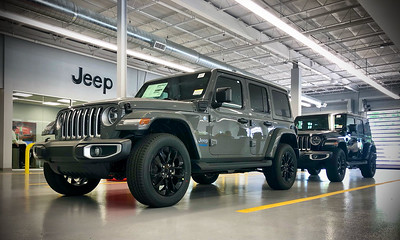The automotive industry sees new advancements introduced yearly. Some vehicles have technological improvements that offer cutting-edge driver-assist systems that semi-autonomously drive the car. Infotainment systems now have the impressive capability to sync with smartphones and access the internet wirelessly from anywhere. Wi-Fi hotspots, wireless charging pads, and remote vehicle operations now appear as standard features on many makes and models.
Therefore, it shouldn’t surprise anyone to find the powertrain continuing to evolve. In the last 10 years, we’ve seen a rapid rise in the popularity of electric vehicles (EVs). These initially began as a green alternative with little to offer in terms of performance, comfort, and style. Today, we find these cars include impressive power, the latest tech, and premium comfort. Still, many buyers don’t understand how these vehicles work. To help, we had our hybrid vehicle experts explain how a hybrid powertrain operates compared to the traditional gas engine.
A Hybrid Vehicle Defined

Hybrid vehicles use a combination of two powertrain systems to propel the car. Most hybrid vehicles use an electric motor and an internal combustion engine. Several hybrid options exist, and they come from a variety of manufacturers.
Parallel Hybrid Powertrain
Manufacturers mainly use a parallel hybrid system but don’t want to confuse the market, so they call it a hybrid. As the name implies, this system uses a standard gas engine alongside an electric motor to move the vehicle. In addition, parallel hybrid cars use a second battery separate from that of the gas powertrain to provide the electric motor with operational energy. The gas engine recharges this second battery as you drive. However, it doesn’t replenish at the same usage rate, leading to the electric battery eventually depleting.
This setup can operate in three modes. First, you can run the gas engine with an electric motor. Simultaneously running both adds driving range. Second, you can shut off the gas engine and operate it only using the electric motor. Third, you can use only the gas engine without the electric motor. Typically, hybrid drivers use gas-only power only after depleting the hybrid battery.
The ability to operate with only the gas powertrain allays the common fear of being unable to recharge the battery and getting stranded. Even with the rapid growth of EV charging stations, you can always find a gas station, so you’ll never be left immobile. Drivers new to EV ownership gravitate to this type of EV.
Mild Hybrid Powertrain
Some manufacturers employ a mild hybrid system with a smaller electric motor and battery than a regular hybrid system. As a result, you don’t see much improvement in efficiency. Instead, you get more power to the engine and a modest increase in your driving range.
Plug-In Hybrid Powertrain
The plug-in hybrid powertrain operates the same way as a standard hybrid powertrain. However, a plug-in hybrid system usually has a larger electric motor and battery. In addition, the battery needs to plug into an external power source to recharge fully. Some hybrids now have regenerative braking systems that return energy used in the braking process to the battery, which increases the range.
Plug-in hybrid electric vehicles (PHEVs) have longer driving ranges because of their larger batteries. In most cases, they can travel 30 miles or more in electric-only mode, offering substantial savings for those with short commutes.For example, the average American commutes 41 miles per day. So, if you drive the Chrysler Pacifica PHEV, you have a 32-mile range in electric-only mode and would only need the gas engine for nine miles of your commute. In addition, companies have started installing charging stations for customers and employees to use, many at no cost. In that case, you could drive to work, plug in, and return home without using the gas engine.
Series Hybrid Powertrain
The series hybrid powertrain also features a gas engine and an electric motor powered by a separate battery. However, the gas engine doesn’t connect to the drivetrain. Instead, it exists only to recharge the battery. This gas engine doesn’t produce enough electricity to recharge the battery fully, but it does extend the driving range.
Hybrid Powertrain Pros and Cons
Pro: Increased Efficiency
The ability to propel your vehicle using an electric-only powertrain saves you money. Simply put, electricity costs less than gas. Likewise, the hybrid powertrain offers savings with fewer stops at the gas pump. For example, the PHEV Jeep Wrangler 4xe uses a 2.0-liter turbo engine and two electric motors powered by a lithium-ion battery pack that delivers an EPA-estimated 49 MPGe rating. Compare that to the Jeep Wrangler Rubicon with its 3.6-liter V-6 engine that gets 19 mpg combined, and you can see the difference.
Pro: Lower Emissions
A hybrid powertrain produces fewer emissions than an internal combustion engine alone. As a result, the hybrid vehicle has a lower carbon footprint and less of an impact on the environment. And, if you do very little highway driving, you can operate your hybrid using only electricity, lowering your greenhouse emissions more while maximizing efficiency.
Pro: Power Boost
Even a small hybrid powertrain offers more power than a standard gas engine. This is because an electric motor’s instant torque delivers power faster than a gas engine, improving acceleration. In addition to reaching higher speeds in less time, you won’t notice a change in how the vehicle handles because they have the same suspension, steering, and stability control systems as their gas-only counterparts.
Pro: No Range Anxiety
Range anxiety is the primary concern people have when considering electric vehicles. With a hybrid powertrain, you don’t have to worry about driving range because you can always find fuel at a gas station if you deplete your battery.
Con: Higher Price
Ten years ago, the cost to purchase a hybrid vehicle was as high as $15,000 more than its gas equivalent. Today, manufacturers have reduced production costs, which has closed the price gap. For example, the top-tier Chrysler Pacifica Pinnacle model costs $54,167 compared to the Hybrid Pacifica Pinnacle’s price tag of $58,172.
Take a Hybrid for a Test Drive Today
If you’re ready to take the next step in reducing your carbon footprint with a reliable hybrid vehicle, we invite you to explore our inventory online. Or, if you prefer a personal demonstration, you can visit our Plano, Texas, dealership, and one of our hybrid experts will answer all your questions and let you take your favorite for a test drive.




